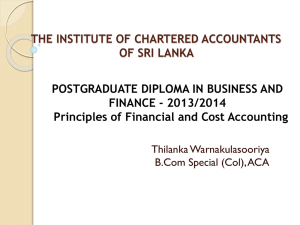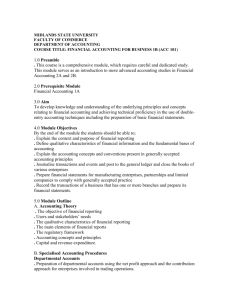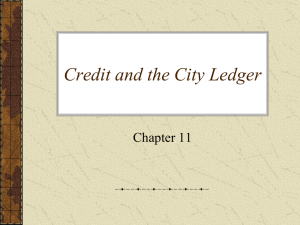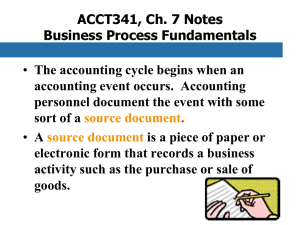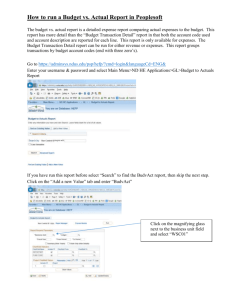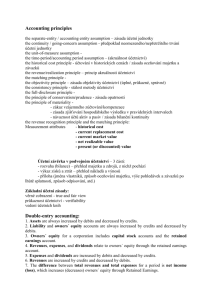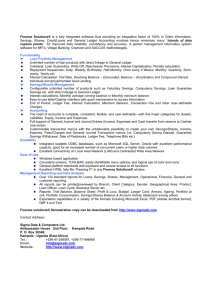SAMPLE QUESTION PAPER-I
advertisement
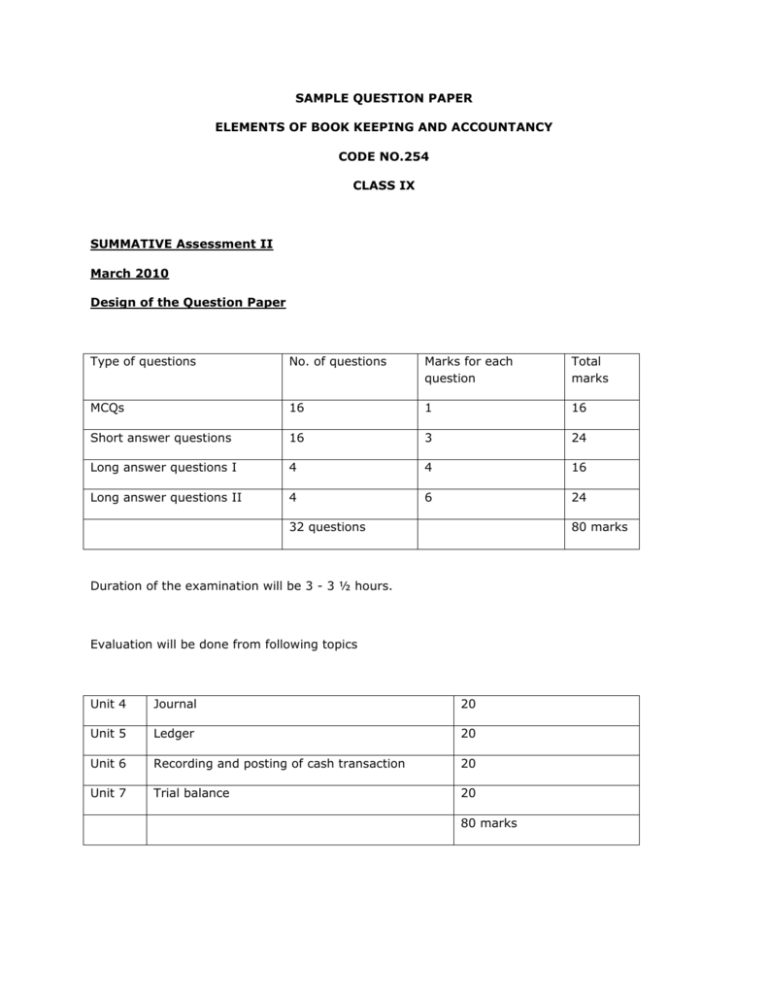
SAMPLE QUESTION PAPER ELEMENTS OF BOOK KEEPING AND ACCOUNTANCY CODE NO.254 CLASS IX SUMMATIVE Assessment II March 2010 Design of the Question Paper Type of questions No. of questions Marks for each question Total marks MCQs 16 1 16 Short answer questions 16 3 24 Long answer questions I 4 4 16 Long answer questions II 4 6 24 32 questions 80 marks Duration of the examination will be 3 - 3 ½ hours. Evaluation will be done from following topics Unit 4 Journal 20 Unit 5 Ledger 20 Unit 6 Recording and posting of cash transaction 20 Unit 7 Trial balance 20 80 marks SAMPLE QUESTION PAPER-I ELEMENTS OF BOOK-KEEPING & ACCOUNTANCY CLASS IX TIME : 3Hrs. Marks-80 General Instructions: 1. The Question Paper has 32 questions in all. 2. All questions are compulsory. 3. Questions from serial No. 1 to 16 are multiple choice questions. These are to be answered by writing the correct option in your answer sheet. 4. Attempt all parts of a question together. Q.1 Business transactions are recorded:(a) in chronological order (b) weekly (c) at the end of the month Q.2 1 Trial Balance is prepared generally for a particular period which is ? (a) week (b) month (c) Quarter (d Year Q.3 1 Goods returned of Rs. 500/- by Anil will be entered in(a) Purchases Book (b) Purchases Returns A/c (c) Sales Book (d) Sales Returns Book Q.4 1 Purpose of Sales Book is(a) To record all sales made by the firm (b) To record payment due to creditors (c) To record all credit sales made by the firm (d) to record credit sales of goods made by the firm 1 Q.5 Salaries paid to staff will be debited to which A/c? (a) Salary A/c (b) Cash A/c (c) Staff A/c (d) Expense A/c Q.6 1 A ledger is called a book of :(a) Primary entry (b) Secondary entry (c) Final entry Q.7 1 A Ledger Account is prepared from:(a) events (b) transactions (c) Journal Q.8 1 Cash book is used to record. (a) All Cash receipts only. (b) All Cash payments only (c) All Cash & credits sales (d) All receipts & payments of Cash 1 .Q.9 Why is Journal called a book of original entry? 1 Q.10 Transactions entered on the debit side of cash book are posted to which side of concerned ledger Account? 1 Q.11 If the total of the debit side of cash book exceeds the total on the credit side what does it indicate. 1 Q.12. What is the meaning of Imprest System of Petty Cash? 1 Q.13. What is meant by the term Trial Balance? 1 Q.14. Is Agreement of Trial Balance the final proof for accuracy of accounts? 1 Q.15. Name the two methods of preparing a Trial Balance. 1 Q.16. What is the meaning of Ledger? 1. Q.17. Prepare the Purchases Book From the following details:- 3. (a). Purchase of goods costing Rs. 5000 from M/s. Ramesh vide invoice no. 120 dated 15.09.2009 (b). Purchase of Fixed Assets costing Rs. 8000 from M/s. Renu vide invoice no. 016 dated 20.09.2009. (c) Paid wages Rs. 600 in cash vide receipt no.16 dated 25.092009. Q.18. Classify the following under the three types of accounts ( Real, Nominal or Personal): (a) Drawings (b) Cash (c) Capital (d) Machinery (e) Bank (f) Depreciation 3. Q.19 . Give any three uses of a ledger. 3. Q.20 Differntiate between Journal and Ledger on the basis of any three points. 3. Q.21 Cash Book is both a Journal & a ledger (Explain) 3. Q.22.Give three examples of entries which appear in a ‘Journal Proper’. 3. Q.23 . Write any three limitation of preparing a Trial Balance. 3. Q.24. State whether the following will have debit or credit balance ? (a) Sales (b) Purchase Return (c) Capital (d) Salary (e) Rent Paid (f) Purchases 3 Q.25. Enter the following transactions in a appropriate Subsidiary Books of Ramesh for the month of January 2009: 4 Date Transactions Rs. Jan.1 Sold goods to Ram 5,000 Jan.5. Purchased goods from Hari Ram 2,000 Jan.15 Returned goods to Hari Ram 500 Jan.25 Ram Returned Goods 800 Q.26. Rearrange the following steps in preparing ledger: 1. Enter the relevant amount in the ‘amount’ column . 2. Record the page no. of the Journal . 3. Identify in the Ledger the account in which transactions are to be recorded. 4. Enter the date of the transaction in the date column. 4 Q.27. Insert the following in Tabular Petty Cash Book. On 1St Feb. 2009 Rs. 40 were given to petty cash clerk. 4 Feb2009 Transactions Amount (Rs.) 1. Chowkidar’s Wages 15.00 2. Pencils 5.25 8. Railways freight on Account of books 2.31 12. Postage Stamps 1.25 14. Telegrams 2.44 15 Sundry Expenses 0.56 28. What is the main objective of preparing a Trial Balance? 4 Q.29. Journalise the following transactions 6 Date Transactions Rs. Jan.1 Started business with cash 50,000 Jan.3 Sold Goods to Rohan 40,000 Jan .7 Goods purchased from Sohan 20,000 Jan.20 Paid Rent 500 Jan.25 Commission Received 200 Jan.30 Machinary purchased 10,000 2009 Q.30. Pass the Journal Entries of M/s. Ram Traders. Post them to the Ledger from the following transactions: 6 Date Transactions Rs. 2009 April 1 Commenced Business with cash 1,50,000 April 3 Purchased Furniture 25,000 April 5 Goods purchased 30,000 April 15 Cash Sales 40,000 Q.31.From the following information, draw up a Trial Balance in the books of Shri Subhash Chand as on 31st March,2009: 6 Transactions Rs. Capital 1,50,000 Purchases 40,000 Transactions Rs. Sales 1,05,400 Sundry Creditor 5,000 Cash in Hand 7,000 Rent 2,000 Cash at Bank 8,500 Furniture 16,000 4,800 Bank Loan 10,000 500 Investment 6,000 2,400 Commission paid 1,050 8,000 Opening Stock 3,200 1,60,000 Commission Received 1,200 11,400 Postage & Telegram 750 Electricity exp. Stationery Office Equipment Sundry Debtors Machinery Salaries Q.32.Prepare a Cash Book with discount column of Shri Shyam from the following transaction. Enter the following in Shri Shyam’s Cash Book and show the Balance: 2009 March 1 Balance of cash in Hand Rs. 25,000 March 3 Rent paid Rs. 2,000 March 5 Purchased goods for cash Rs. 10,000 March 10 Stationery purchased Rs. 2,500 March 12 Sold Goods for Cash for Rs. 8,000 March 15 Cash received from Ram Rs. 980 and discount allowed Rs.20 March 18 Cash paid to Shyam Rs.950 and discount Received Rs.50 March 25 Wages Paid Rs. 2,000 6 ELEMENTS OF BOOK-KEEPING & ACCOUNTANCY SAMPLE PAPER-I Marking Scheme Q.1. (a) Q.2. (d) Q.3. (d) Q.4.(d) Q.5. (a) Q.6. (c) Q.7. (c) Q.8. (d) Q.9. It is a basic book of original entry in which transactions are analysed before they are posted in the ledger. Q.10. Credit Side. Q.11. Cash in hand at the end of the period. Q.12. Under the Imprest system, the Head cashier makes the reimbursement of the amount spent by the petty cashier. Q.13. Trial Balance is a statement which shows either the balance or total amounts of debit items and credit items of all accounts in the ledger and the cash and bank balances. Q.14. No Q.15. (a) Balance Method (b) Total Amount Method Q.16. A Ledger is a principal book which contains all the accounts to which the transactions recorded in the books of original entry. Q.17. Purchase Book Balance Rs. 5,000 Q.18 (a) Personal Account (b) Real Account (e) Personal Account (f) Nominal Account Q.19. (c) Personal Account (d) Real Account (i) It provides complete information about all accounts in one book. (ii) It facilitates the preparation of final accounts. (iii) It enables to ascertain what the main items of revenues, expenses, assests and liabilities are and of what amounts. Q.20. Point of Distinction Journal Ledger 1. Nature It is a book of primary entry It is a book of final entry Recording in the journal is the first stage. 2. Stage of Recording Journal is not balanced Recording in the ledger is the second stage. All ledger accounts (except nominal accounts) are balanced in the ledger 3. Balancing Q.21. The Cash Book is a book of original entry since transactions are recorded for the first time from the source document. The Cash Book is a ledger in the sense that it is designed in the form of a Cash Account and records Cash receipts on the debit side and cash payments on the credit side, Thus, the Cash Book is both a journal and a ledger. Q.22.(i) Outstanding Expenses. (ii) Prepaid Expenses (iii) Entries for Dishonor of Bills. Q.23. Limitation of a Trial Balance- A Trial Balance is not a conclusive proof of the accuracy of the books of accounts since certain types of errors remain even when the Trial Balance tallies. The following errors do not affect the Trial Balance at all. (a) Error of Principle, (B) Compensating error, (c) Error of complete omission (d) Error of Recording in the books of original entry. Q.24 (a) Credit (b) Credit (c) Credit (d) Debit Q.25. Sales Book Rs. 5,000, Purchase Book Rs. 2,000, Return Book Rs. 800. (e) Debit (f) Debit Purchase Return Book Rs. 500, Q.26 In order of 3-4-2-1. Q.27. Total Payment Rs. 26.81 Balance c/d Rs. 13.19 Grand Total Rs. 40.00 Cash Required Rs. 26.81 Q.28. (i) To ascertain the arithmetical accuracy of Ledger accounts. (ii) To help in locating errors. (iii) To facilitate the preparation of financial statements. Q.29 Date Particulars 2009 Cash A/c Jan.1 Debit (Rs.) Dr. To Capital A/c Credit (Rs.) 50,000 50,000 Sales (Being the business started with cash) Jan.3 Rohan Dr. 40,000 To Sales A/c 40,000 (Being the goods sold to Rohan) Jan.7 Purchase A/c Dr. 20,000 To Sohan 20,000 (Being the goods purchased from Sohan) Jan.20 Rent A/c Dr. 500 To Cash A/c 500 (Being the rent paid) Jan. 25 Cash A/c Dr. 200 To Commission Received A/c 200 (Being the commission received) Jan.30 Machinary A/c Dr. 10,000 To Cash A/c 10,000 (Being the machinery purchased) 1,20,700 Q.30. Balance of following ledger Purchase A/c Rs. 30,000, 1,20,700 Cash A/c Rs. 1, 35,000, Furniture A/c Rs. 25,000, Sales A/c Rs. 40,000. Q.31. Trial Balance Total Rs. 2, 71,600. Q.32. Cash Book Balance C/D Rs. 16530.00, Discount Dr. Rs. 20.00, Discount Cr. Rs. 50.00.
